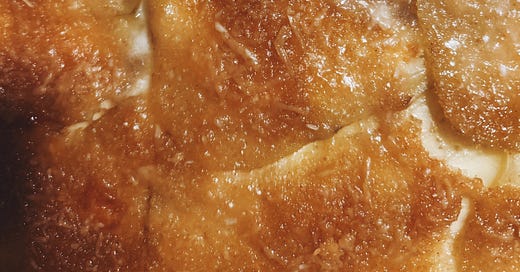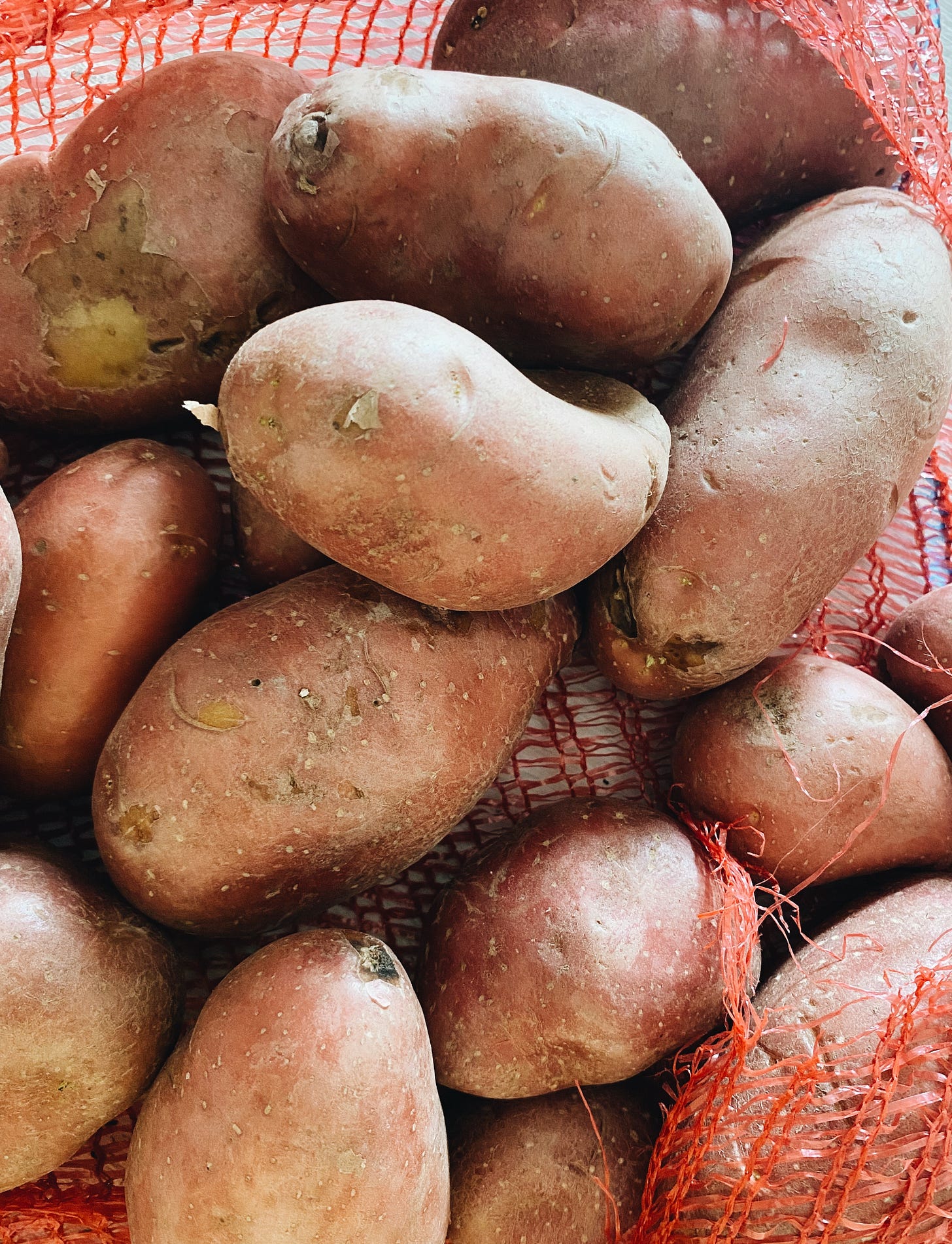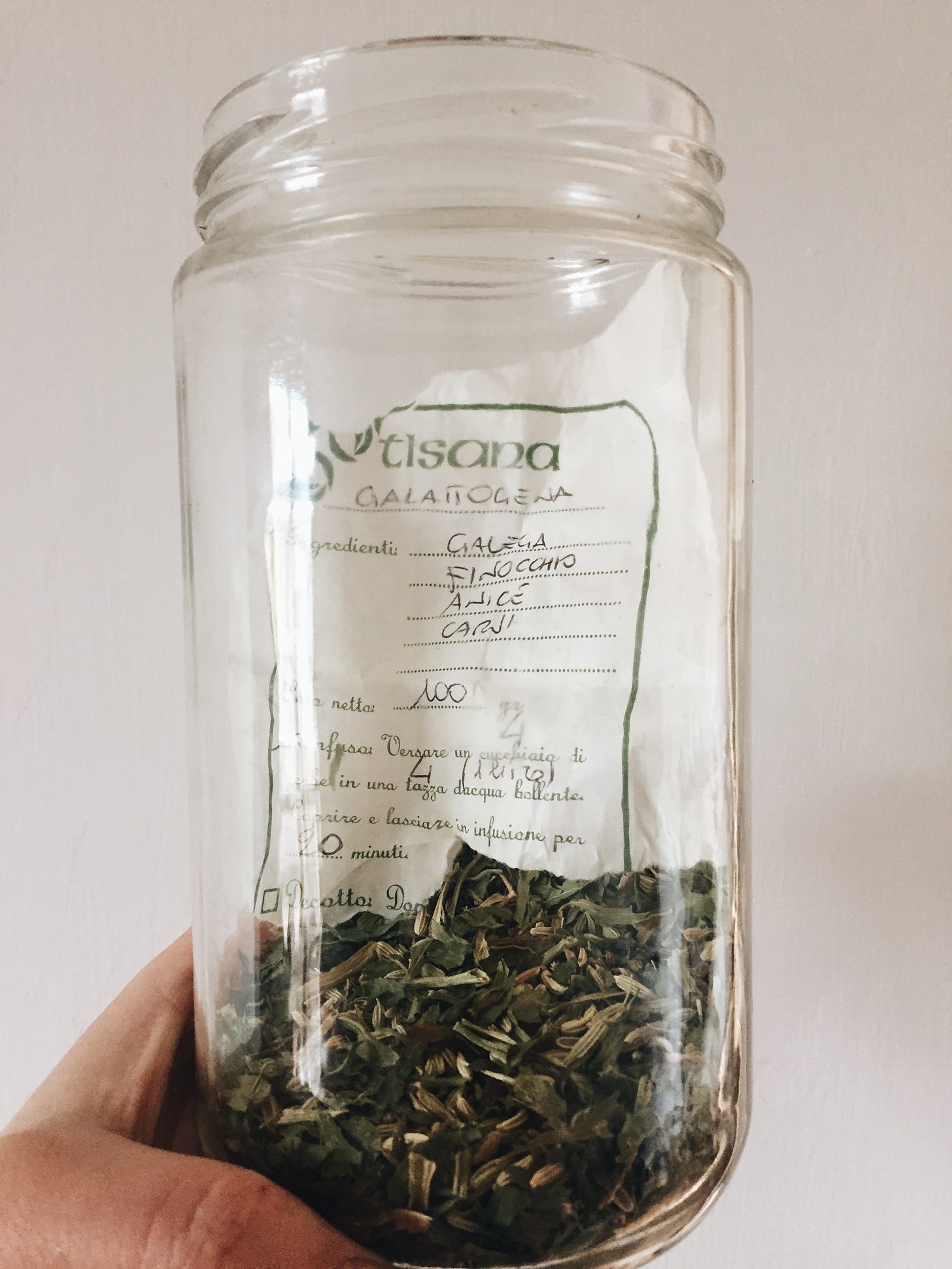Creamy Potato and Fennel Gratin
Vegetarian, Gluten + Lactose Free. The Last Supper + Eating Through Loss.
I woke up early that rainy Saturday morning to roast a fresh white head of cauliflower and some leggy carrots with whispy green tops. Their smokey syrup coated a bowl of salad leaves, toasted hazelnuts and salty feta. Then, with a shake shake shake of an old honey jar, I mixed up a creamy orange tahini dressing. The salad went into a shopping bag to join a few punnets of strawberries, a large piece of local pecorino semi-stagionato, and a tangly green bunch of leathery pods whose baby-soft interiors held the exciting promise of the season’s first broad beans - le fave. I was headed to a basket making workshop over the border in Umbria, and it was everything I could do to shoo the family into the car so that they could drop me off on time.
When I finally landed in the passenger seat, I glanced at my phone to see a missed call and a text from one of my closest friends. I opened the message and blinked twice as I read the words. ‘Call me, I’ve sad news. It’s X, he passed away yesterday.’ I immediately rang her for a brief chat, and instead of driving north, Riccardo did a U-turn under the ominous sky to drive myself and the children to our preferred pasticceria in Rieti, where we gathered around our cappuccini and pastries in silent disbelief.
I have been thinking a lot about food and loss this past week and our solo and shared meals in these moments. I thought about the lopsided candy red maraschino cherry that slid down the side of the hot fudge sundae from Friendly’s restaurant that my grandmother requested on her deathbed. I remembered her, a frail little bird, swallowing it as if it were manna from heaven and her delicate mouth flecked with whipped cream. I thought about checking out of the hospital in Reggio Calabria with a mission to find a pasticceria that sold gluten-free cake (an entire one to be consumed in one sitting) to soothe the trauma of all that was involved in the loss of our first baby. I thought about the freshly made hummus prepared by another dear friend on a warm Irish summer’s day that we enjoyed in her garden in Dun Laoghaire as we drank prosecco out of her granny’s antique champagne glasses on our last proper afternoon together. I recalled her request for a takeaway McDonald’s on her last trip to drink in the sea and then pondered the unique exchanges of witty banter, intense chats, unparalleled laughter, and times past that would be no more.
In these days, I also thought about the last hours of my friend who decided to take his own life. I wondered if he carefully chose what he would eat as his last supper or if the pain was too big for such details. This is a question that we figuratively ask ourselves and others, ‘What would your last meal be?’ Then I found the courage to scroll through his texts, ‘I love nature and cooking and sun of course, I’m getting old’. I remembered our intense conversations about Irish Christmas dinners and how braised red cabbage was essential for him. This is a side dish which I will now include in every holiday spread going forward.
Eat this in memory of me.
Culturally, I reflected on, and now feel the need to research, what traditional Irish wake and funeral food might have been through the centuries before today’s bowls of soup, sandwiches and the odd chicken goujon.
I thought about how after attending my first funerals here in Italy, I felt the terrible void of the anticlimax. ‘You just go home? What do you mean you just go home?’ Coming from Irish and American culture, where mercy meals help to bring celebrations of life to a close, I have also developed a curiosity around these traditions in Italy.
Food as loss.
Every kind of loss in this life is a little death that we need to be born again and again as part of our metamorphosis. What were you eating before, during or after you lost that person, place or thing? Do you remember?
We all know that loss can be sudden, or it can be the long. slow. burn. of the hot summer sun dripping down the shaded sky to meet the horizon. Life, if you think about it, is one long road of loss — of things fading out at different speeds, but should we frame this as loss or as the continuous movement and transformation of energy in time? Yes, we lose things as we have known them, but are they really gone?
To continue the theme of my last few pieces, most unintentionally, this recent and quite sad event has also called me back to reflect yet again on the changing of these many seasons that we experience in life and the food that we find here. Nature is our mirror, and so the radicchio, the fennel, the strawberries, the nettle, they do not just get up and leave us one day. They also join us on this journey of fading in and out. Regardless, we brace and shape ourselves in the slow loss of things, for the moment of their passing.
End-of-season produce is abundant here in Rieti, and in its overflowing accessibility, it offers us a lesson. Overflowing bins of discounted fennel at the supermarket have been saying ‘appreciate me while I am here’ and so have our potatoes from Leonessa, which are now beginning to sprout in our cold, damp underground cantina. These little events and the cold spring winds that continue to blow off the snowcaps of mount Terminillo reminded me that it was a good time to enjoy a warming gratin of potato and fennel. This is a recipe that I will now associate with these days.
There is a moment that exists in the blurry distance just beyond the pain, which calls us to look back on what was with love and gratitude. Where we are called to admire the beauty of blossoming trees as a reminder of hope, possibility and the promise of all that is due to explode into life in the seasons ahead.
We tend to mourn the passing of things that we associate with different seasons — the cosy sweaters, warm fires and the ingredients that hold space at the top of our winter ingredient lists — but vegetables like fennel, which we associate with cold-weather eating, are still here until May and radicchio until June. New potatoes are now rolling in to replace the old.
Fennel is wonderful for digestion so I consume it often in its raw and cooked form and I drink it as a tea or tisana. I fell in love with this ingredient in my late twenties when I took an intensive professional cooking course at a cooking school in Dublin. We were asked to bake it in a saffron and mascarpone sauce, and I remember the soft, sweet anise flavour hitting my young palate and being completely blown away. If this is not an ingredient that you are familiar with, then I am asking you to give it a try.
During this course, I also learned to make béchamel sauce, which is a French and Italian kitchen essential. In Ireland, we know it as ‘white sauce.’ Can you bake the potatoes and fennel without the béchamel sauce to please the vegans in the house? Well, yes, you can, and I have done this, but I really feel that the addition of the creamy béchamel just hits all of the right spots on these still-chilly evenings. You can find a vegan recipe here as part of the method for this Tarte Tatin with Wild Herbs + Potatoes, and I will be publishing my own step-by-step recipe in the future (one thing at a time).
I will continue writing about béchamel sauce in my next post, and I will also include a step-by-step tutorial for those of you who don’t already have the skill. There is nothing like the cosy smell that permeates the air when Parmigiano and béchamel mingle in a hot oven. You know the one.
Potato and Fennel Gratin
Patate e finocchi gratinate con la besciamella
V+GF+LF
Serves 6-8
FOR THE GRATIN
Ingredients:
1kg potatoes
600g fresh fennel
30g regular or gluten-free bread crumbs
80g Parmigiano Reggiano cheese
1L béchamel sauce*
A few sprigs of fresh thyme*
Extra virgin olive oil
Sea salt and freshly ground black pepper
Method:
Heat your oven to 180° Celsius.
Prepare your béchamel sauce (recipe below) and keep warm.
Peel, wash, and pat dry the potatoes. Slice the fennel down the middle, gently rinse it, and pat it dry. Finely grate the cheese.
Cover the bottom of a standard 33 cm x 23 cm baking dish with a thin layer of béchamel sauce.
Use a mandoline slicer to thinly slice 1/3 of the potato to cover the bottom of the baking dish, then thinly slice 1/3 of the fennel on top of the potato. Lightly season and then spread 1/3 of the béchamel sauce over the entire surface using the back of a spoon. Cover with 1/3 of the cheese and sprinkle with freshly picked thyme leaves.
Add a second layer with another 1/3 of the potato, fennel, béchamel sauce, cheese and thyme.
To finish, add the last layer of thinly sliced fennel and then finish with the last layer of thinly sliced potatoes. Lightly season and then spread the last of the béchamel sauce evenly over the top.
Mix your breadcrumbs and cheese and sprinkle over the top of the dish. Lightly drizzle with olive oil (or add a few pats of butter if you are feeling indulgent) and bake for 35-45 minutes until bubbling and the top is golden brown.
Notes:
Herbs like parsley, marjoram and three-corned leek (a form of wild garlic) can be substituted here and can be directly added to the béchamel sauce. I like to choose one.
Immerse the potatoes in water if you are not using them immediately to avoid discoloration.
Keep an eye on the top of the gratin. If it starts to take on too much colour, you can slip a sheet of aluminium foil into the oven to cover it to avoid burning.
For the bechamel:
Ingredients:
1L regular or lactose-free whole milk
100g regular or gluten-free flour blend
100g regular or lactose-free butter
Fresh nutmeg
Sea salt and freshly ground black pepper
Method:
Sift the flour.
Warm your milk in a small sauce pan over low heat. Do not let it boil.
Melt the butter in another small sauce pan over low heat. Add the flour to the butter and stir constantly with a wooden spoon for 2-5 minutes until it comes together to form a light golden sandy roux.
Add the warm milk to the pan in a slow, thin stream, stirring continually with a whisk or wooden spoon.
Continue stirring until combined. Season with salt, a few pinches or gratings of fresh nutmeg and a bit of pepper if you wish. Simmer the sauce over very low heat for about 15 minutes, stirring occasionally. The béchamel sauce should be thick enough to thinly coat the back of a spoon. Keep warm.
Notes:
I use a generous amount of béchamel sauce here because I think it works. Feel free to cut it in half if you think you would prefer less of a creamy finish. It’s ok if there is a bit left over.
The sauce will thicken if you leave it to cool. Warm it up to bring it back to life. If you find your sauce too thick, add a few splashes of warm milk, stirring. If it is too thin then add another small knob of butter rolled in flour.
For the best gluten-free finish, look out for gluten-free flour blended specifically for sauces. A simple rice flour can do the job as well.
Stay tuned for a step-by-step visual guide to the above béchamel sauce (yes, there is more to talk about) and crêpes (crespelle). I will also be publishing my recipe for lamb ragù as it is prepared here in Sabina. All to get you ready for Easter dinner and spring entertaining.












So sorry for your loss. What a nice way to keep someone alive through food. Sending lots of hugs 🫂